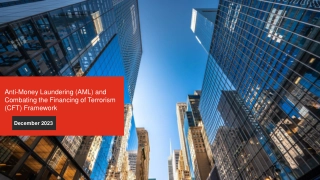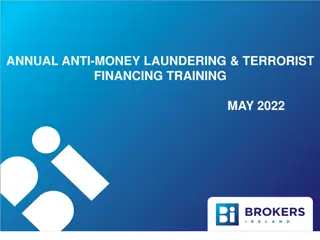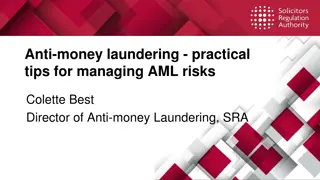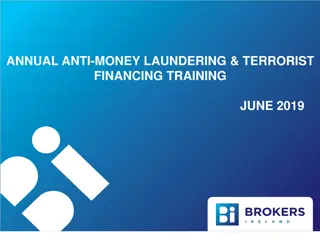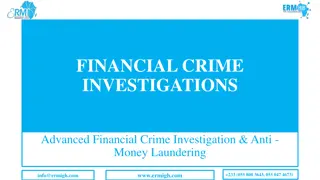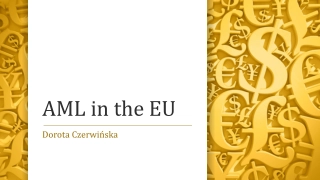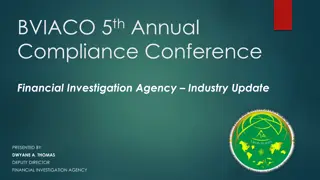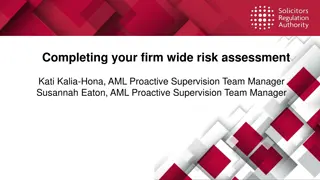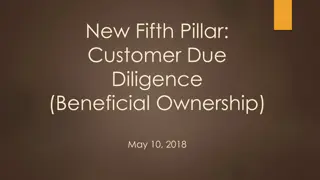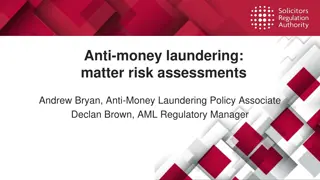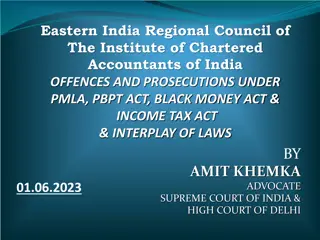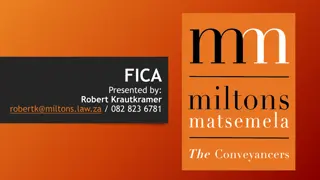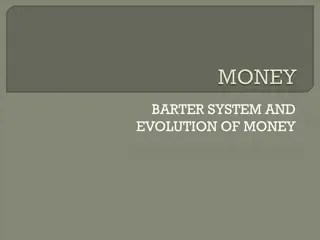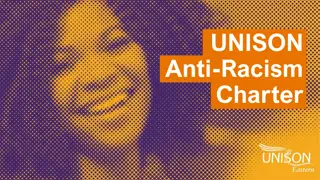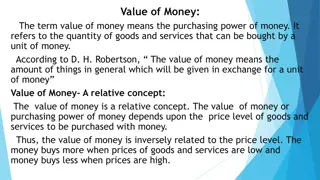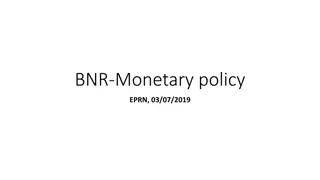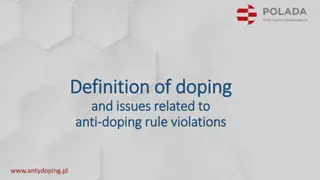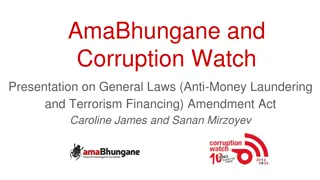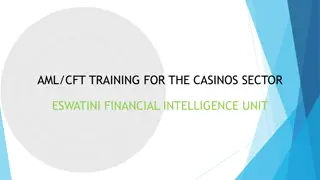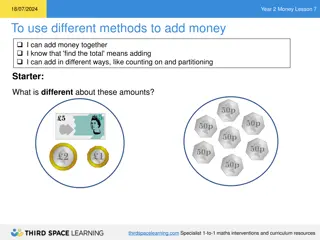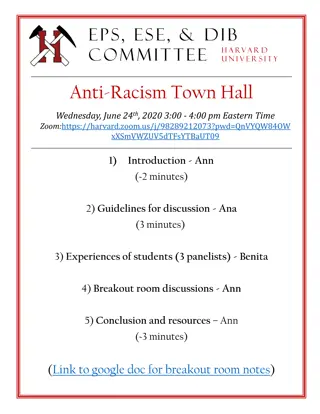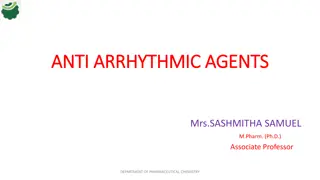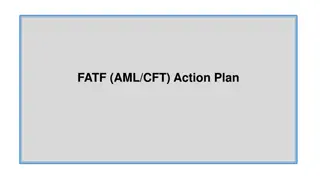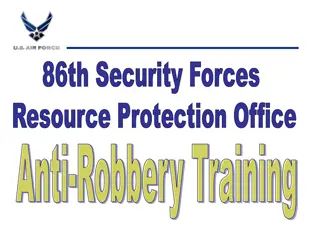Anti-Money Laundering Training Overview
This training example provides insights and tips on Anti-Money Laundering (AML), covering topics such as understanding money laundering, risks in the accountancy sector, criminal perspectives, predicate crimes, and more. It emphasizes the importance of tailored and comprehensive training to combat financial crime effectively.
Download Presentation

Please find below an Image/Link to download the presentation.
The content on the website is provided AS IS for your information and personal use only. It may not be sold, licensed, or shared on other websites without obtaining consent from the author. Download presentation by click this link. If you encounter any issues during the download, it is possible that the publisher has removed the file from their server.
E N D
Presentation Transcript
DISCLAIMER: THIS TRAINING POWERPOINT EXAMPLE IN ITS CURRENT FORMAT WOULD NOT BE SUFFICIENT TRAINING FOR THE MLRO OR TO GIVE TO YOUR EMPLOYEES. THIS IS AN EXAMPLE WITH HINTS AND TIPS ONLY. IT MUST BE ADAPTED AND EXPANDED UPON TO ENSURE IT IS RELEVANT TO YOUR FIRM, ITS EMPLOYEES, CURRENT LEGISLATION, REGULATORY GUIDANCE AND CURRENT TRENDS, THEMES AND RISKS.
Money Laundering Explained. Is the following statement true or false? Money laundering is the concealment of the origins of illegally obtained money. Terrorist financing is providing funds to sponsor or facilitate terrorist activity. Terrorist income often combines clean and dirty money. True Is the following statement true or false: Money laundering only ever occurs when physical cash derived from criminal activity is given to someone else. True 5
Accountancy sector ML risks National Risk Assessment of MLTF 2020, accountancy sector was highlighted as a crucial gateway for criminals looking to disguise the origin of their funds. Accountants fail to recognise the threat of money laundering. Accountants involved in money laundering cases tend to be negligent or unwittingly involved. The sector is assessed as high risk as the services they provide can be used to: Create corporate structures which disguise activity Gain legitimacy Facilitate transactions through client accounts Evade tax
Think like a criminal A client has approached you to use your services to launder 250k. The funds are currently in cash. What advice and assistance would you give to make these funds appear legitimate?
Predicate Crimes What possible crimes could occur prior to the act of money laundering? Cyber crime Fraud Bribery corruption Sanctions evasion Tax evasion Drug trafficking Modern slavery Human trafficking Firearms offences Child sexual abuse Organised immigration Terrorism
Modern Slavery and Human Trafficking Indicators Some of the businesses known to be linked to exploitation are agriculture, high cash- generative personal service businesses, cleaning companies, construction and maintenance businesses, and transport and freight. Cash-based business potentially used to exploit victims and pass unexplained funds through Business output not proportionate with size and staffing levels Client holds a diverse portfolio of businesses in high- risk industries e.g. construction, takeaways, care agencies Unusual, complex structures in place Unclear source of funds/wealth Payments/income received at unusual times of the day Evasive behaviour Extended family involvement in business or transactions e.g. bulk of funds paid to family members Card statements showing payments processed between hours that do not correlate with the type of business it is Irregular hours or pay, yet all staff are paid the same Suspicious lack of staff costs Unclear beneficial ownership Round sum salaries
Tipping Off Explained What is Tipping Off? The offence is committed by a person who discloses information that is likely to prejudice an actual or a proposed investigation before an SAR has been made, or who discloses information that is likely to prejudice an investigation which might be conducted after an SAR has been made to law enforcement, in circumstances where he or she knows or suspects that there is either an investigation or a proposed investigation, or that a disclosure has been made to law enforcement. Misinterpretation of the law The offence is widely misunderstood. It is often mistakenly assumed that enquiries should not be made of customers during the evaluation process for fear that such enquiries might expose an employee to the risk of tipping off the customer. This is not the case. While employee enquiries must be handled with care, to be in danger of committing a tipping-off offence an employee must either know or suspect that an SAR has been, or is to be, made or must know or suspect that an investigation is underway or is planned. This will rarely be the case at the initial suspicion evaluation stage.
Tipping Off Scenario An accountant has been contacted by law enforcement and has been issued with a Production Order on one of his clients which means all relevant documentation must be provided. The accountant has not filed an SAR and is not aware of what law enforcement are investigating. The accountant is concerned about GDPR, so notifies the client. Is this tipping off?
Customer Due Diligence (CDD) What is CDD? Customer due diligence is the process of identifying your clients and checking they are who they say they are. Why it is important? Criminals often seek to mask their true identity for example, by using complex ownership structures. The purpose of CDD is to know and understand a client s identity and business activities so that any ML risks can be properly managed. Risk assessment: a risk assessment on each client to identify the money laundering risk that they pose must be conducted. The following factors need to be considered during this risk assessment: Customer risk Product, service, transaction and delivery channel risk Geographical risk Risk categorisation: the client should be categorised as low, medium or high risk. It is this risk categorisation which determines which level of due diligence should be completed.
Identifying client risk Consider these client profiles. Would you classify them as high, medium or low risk? Sunflower Massage Spa Based in Soho. Operating hours are 12pm to 3am Monday to Saturday. Spa has no official website or social media presence. It is listed on Google and has several reviews. You have found a news article from 2016: Chinatown and Soho: 18 arrested in prostitution and slavery raids as police storm six massage parlours . However, Sunflower Massage Spa was not specifically named. High Risk
Identifying client risk Web Development & Design Company Their website describes them as a web design agency based in Manchester. They have been trading for 11 years. Profits are steady year on year and is in line with industry statistics. Mr. Alan Example is the sole director and UBO. Payments are made electronically, and they can provide invoices. No adverse media information was found. Medium/Normal Risk
Identifying client risk Consider these client profiles. Would you classify them as high, medium or low risk? Mr. S Hoss Mr. S Hoss is based in Iran. He wants to use accountancy services as he is buying several properties in London under the company Ardabil and Co. According to Companies House, Ardabil and Co. formed in June 2021 and he is one of several directors. The firm has registered addresses in London, Tehran and Dubai. The ultimate beneficial owner is the firm Persian Enterprises who are owned by Gulf Limited . High Risk
Identifying client risk Pension Protection Fund (PPF) They describe themselves as a statutory public corporation led by our board and accountable to Parliament through the Secretary of State for the Department for Work and Pensions. It is intended to protect members if their defined benefit pension fund becomes insolvent. It was created under the Pensions Act 2004. Low Risk
Think like a criminal You are an accountant. A client has approached you to use your services to launder 250K. The funds are currently in cash. What advice and assistance would you give to make these funds appear legitimate?
Identifying client risk Ring Ring Mobiles Employs 4 full-time members of staff. Specialises in mobile phone repairs. Sells and buys second-hand mobile phones. Shop also trades on eBay. 2019 Figures show turnover was 36k and overall profit was 2k. Takings for the last 3 months were 3,000, 2,800 & 3,000 respectively. High proportion of customers using credit cards. Owner has recently bought a 400k property.
Identifying Client Risk - Neat Nail Bar (NNB) Neat Nail Bar is based in a residential street in Croydon, London. NNB does not accept card payments owner states he will only take cash payments due to the costs of card transactions. NNB has been open since 2010. For the first seven years the average profit per annum was 60k. Since new owners have taken over in 2018, profits have increased to 200k per annum. Annual records show staff costs were 44k in 2018. Its operating hours are 9am until 9pm Monday to Saturday, 10am to 4pm Sunday. It has three full-time employees. NNB is registered to the Central London address of Sanders Associates, an accountancy firm. Another 81 companies are registered there.
Identifying Client RiskFM FM is a company service provider based in Nevis. Its main source of business is the incorporating and operating of companies in jurisdictions on their clients behalf. It was founded in 1990 and acts for 100k companies with 20 full-time employees. It has offices in Cayman Islands, Bermuda and British Virgin Islands. Clients include the former Sudan president, the prime minister of Andorra and the brother-in-law of the ex-Prime Minister of Malaysia. The client list also includes several shell corporations.
Identifying Client Risk Ioannis Investment Securities Ioannis Investment Securities offer investment opportunities. Rather than offer high returns to all comers, Ioannis Investment Securities offers fairly modest but steady returns to an exclusive clientele. In the last 10 years of trading, returns have always been between 7%-9% per annum. Ioannis Konstantinou generally refuses to meet directly with investors. Some investors who have already invested are wary of removing their money from the fund, in case they could not get back in later. Recently, a proposal pack was published aiming to raise 250m into a new investment fund. Funds will be used to invest in a diverse portfolio of emerging industries to spread risk such as 5G, peer-to-peer lending and cryptocurrencies. In 10 years of trading there were seven losing months during this time, and those losses were statistically insignificant. The accountancy firm handles the credits using the client account and will transfer to one of Ioannis Investment Securities accounts held around the world. The accountant is a sole practice and a close family friend so is trusted by Ioannis Konstantinou.
Money laundering: How trusted professionals can help law enforcement
Your obligation to submit an Internal SAR You must complete an internal SAR should you have knowledge or suspicion of money laundering activity. You may commit an offence if you have knowledge or suspicion of money laundering activity or criminal property, do something to assist another in dealing with it, and fail to make a SAR. This also includes tipping off. Submitting a SAR protects you, your firm and UK financial institutions from the risk of laundering the proceeds of crime.
Submitting good-quality internal SARs Why you are suspicious or have knowledge? When did the circumstances arise? What is the value of the criminality suspected? Who is involved? Where has the suspected criminality taken place? How did the circumstances arise? What is the criminality suspected? How are they involved?
What is a Suspicious Activity Report (SAR)? Suspicious Activity Reports (SARs) alert law enforcement to potential instances of money laundering or terrorist financing. SARs are made by financial institutions and other professionals such as solicitors, accountants and estate agents, and are a vital source of intelligence not only on economic crime but on a wide range of criminal activity. They provide information and intelligence from the private sector that would otherwise not be visible to law enforcement. SARs can also be submitted by private individuals where they have suspicion or knowledge of money laundering or terrorist financing.
Relevant legislation/guidance and publications AML Guidance For The Accountancy Sector ML Regs 2017 FATF Guidance on the Risk-Based Approach for Accountants FATF UK Mutual Evaluation Report HM Treasury national risk assessment FATF RBA Guidance for Accountants Transparency International Report: At your service Review NCA website and relevant material
Why it matters One whistle-blower said, We would work anything from 80-90 hours per week and pay would be from 3- 4 per hour. The payslip would show 37.5 hours worked per week and the rate would be the minimum wage rate, but that's not what we got. It was all for show . They explained that everyone was always paid in cash and not into a bank account. If anyone didn t like the rate they could go elsewhere, but all the factories would have similar rates so there really was no choice, especially if anyone was an illegal immigrant. The driver has been charged with the manslaughter of the 39 victims as well as people trafficking, immigration and money laundering offences. Two brothers, Ronan and Eamon Hughes, one of which has admitted manslaughter whilst the latter is on the run, owned the haulage firm. It s likely that these men used the services of an accountant. Ronan Hughes estimated his haulage business had a turnover of between 500,000 ( 484,000) and 600,000 ( 538,000) but said his business was not very profitable. Mr. Hughes has access to numerous vehicles and more than 200,000 ( 173,000) in 33 bank accounts. The judge said he found unconvincing Mr. Hughes' claim of a lack of awareness of his financial affairs.


